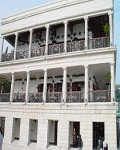Murray House
Archaeology »
Archaeological Monuments » Murray House
Murray House -
Murray House is located in Stanley.
Murray House monument was established on 1844.
Primary threats to Murray House :
It was named after Sir George Murray, the British Master-General of the Ordnance at the time of construction. The designer and constructor are Major Aldrich and Lieutenant Collinson of the Royal Engineers. It was initially used as barracks by the British military.
Historical facts of Murray House :
- Murray House is a historical building located in Hong Kong. Originally constructed in the mid-19th century, Murray House has a rich and fascinating history. Here are some historical facts about Murray House:
- Origin and Construction : Murray House was originally built in 1846 as officers' quarters for the British forces stationed in Hong Kong. It was named after Sir George Murray, the then British Secretary of State for War and the Colonies.
- Relocation : In 1982, due to urban development plans in Central, Murray House faced demolition. However, the government decided to relocate the entire building to Stanley, a neighborhood on the southern coast of Hong Kong Island. The building was carefully dismantled, each brick labeled, and then reconstructed in its new location between 1998 and 1999.
- Architecture : Murray House is a prime example of colonial architecture. Its design reflects classical Georgian and Neoclassical styles, featuring a two-story colonnade with Doric columns, symmetrical façades, and spacious verandas. The building overlooks the picturesque Stanley Bay.
- Historical Significance : Murray House has witnessed significant events throughout its history. It served as an important administrative and social center during British colonial rule in Hong Kong, housing government offices and providing accommodation for high-ranking officials.
- The Japanese Occupation : During World War II, when the Japanese occupied Hong Kong from 1941 to 1945, Murray House was used as a barracks for the Japanese military. After the war, it was returned to British control until the handover of Hong Kong to China in 1997.
- Revitalization : Following its relocation to Stanley, Murray House underwent an extensive restoration and revitalization project. It was transformed into a commercial complex, housing a variety of shops, restaurants, and bars. The project aimed to preserve the building's historical character while creating a vibrant space for locals and tourists to enjoy.
- Haunted Legends : Murray House has gained a reputation for being haunted, with tales of paranormal activity and ghost sightings. These legends have contributed to its intrigue and attracted visitors interested in supernatural phenomena.
- Cultural Landmark : Murray House has become an iconic landmark in Hong Kong. Its elegant architecture and waterfront location make it a popular spot for photography, and it has been featured in movies, television shows, and advertisements.
- Relocation Controversy : The decision to relocate Murray House from its original location in Central was met with controversy and criticism. Some argued that it should have been preserved in its original setting, while others appreciated the effort to save the building and provide it with a new purpose.
- Historical Legacy : Murray House stands as a reminder of Hong Kong's colonial past and the cultural heritage associated with that era. It represents the architectural and historical significance of British colonial buildings in Hong Kong, offering a glimpse into the city's diverse and ever-evolving identity.
- In summary, Murray House in Hong Kong is a historical building that has witnessed the city's transformation over the years. From its origins as officers' quarters to its relocation and revitalization in Stanley, Murray House reflects the architectural and historical legacy of British colonial rule. Its preservation and transformation into a vibrant commercial complex have allowed it to continue playing a significant role in Hong Kong's cultural landscape.

